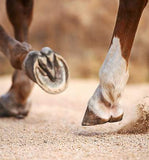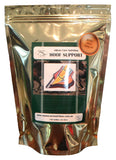Feeding the hoof: protein
 The equine hoof is very metabolically active tissue: it needs to be continually replaced as the lowest section is rubbed away by contact with the ground. A healthy adult horse will grow 6-10mm of new hoof each month: a new hoof capsule every 9-12 months. Growth rates are faster still for foals and young horses. To support such active growth the horse needs good quality nutrition: any deficiencies in the horse's diet soon become apparent in the hoof.
The equine hoof is very metabolically active tissue: it needs to be continually replaced as the lowest section is rubbed away by contact with the ground. A healthy adult horse will grow 6-10mm of new hoof each month: a new hoof capsule every 9-12 months. Growth rates are faster still for foals and young horses. To support such active growth the horse needs good quality nutrition: any deficiencies in the horse's diet soon become apparent in the hoof.
If the horse is lacking one or more of the nutrients it needs to do the job of healthy regeneration, hoof quality will suffer. Thin walls, thin soles, flaking, cracking, chipping, breaking and slow hoof growth can all be a result of dietary deficiencies. A compromised hoof can cause discomfort for the horse, and a breakdown in the integrity of the hoof wall provides an ideal site for bacterial and fungal pathogens to take hold. Those 'seedy toe' bugs out there in wet paddocks just love a crack or chip!
A CLOSER LOOK AT PROTEIN . . .
After water, protein is the most abundant substance in the horse's body. The hoof wall is over 90% protein, so any deficiency is going to show up pretty quickly. But in order to understand how protein affects the hoof we need to break it down a bit further. Different types of protein are made up of chains of amino acids: they are the building blocks of protein. Now it gets a bit more complicated....amino acids can be further divided into non essential and essential. Non essential amino acids can be synthesised and put together within the horse's system, whilst ESSENTIAL amino acids must be provided through the diet. With me so far?....just a bit more....If an essential amino acid is not being provided in adequate amounts it becomes a 'limiting' amino acid: the lack of this amino acid disrupts normal protein synthesis. Once the 'limiting' amino acid is used up, the horse cannot make the amino acid chains its body may still need.
. . . AND BACK TO THE HOOF
The effects of a 'limiting' amino acid can be seen in the hoof. The hoof is made from the major structural protein keratin. Keratin is primarily made from the amino acids alanine, glycine and cysteine (which is produced from methionine). Alanine and glycine are non essential, the horse can make these in its system, but methionine is essential and must be provided through diet. The horse can make as much alanine and glycine as it needs, but if it is not getting enough methionine through diet, it cannot make sufficient keratin, the protein building block of the hoof.
Protein is essential to healthy hoof growth, and it's not just quantity, but type of protein that counts.
|
RELATED PRODUCTS |
|||
 |
 |
 |
 |
| Lysine | Hoof Support |
Hoof Builder |
Omega-3 |